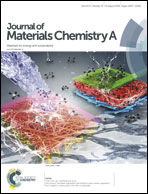Nitrogen-doped bamboo-like carbon nanotubes as anode material for high performance potassium ion batteries†
Abstract
Potassium ion batteries (KIBs) have attracted tremendous attention because of the abundance of potassium resources and the applicability of carbonaceous materials for use as anodes, which indicates that the manufacturing techniques of lithium ion batteries can be directly transferred to KIBs. However, the huge volume change during the potassiation/depotassiation process, and the poor kinetics of the large K+ ions seriously restrict the electrochemical performance of graphite because the K+ ions are squeezed into the restricted interlayer spacing. Compared with well-crystallized graphite, amorphous carbon has a more flexible structure, but its capacity contribution is mainly dependent on a capacitive storage mechanism. Therefore, finding a carbon material with a suitable degree of graphitization and structure is necessary to achieve superior electrochemical properties. In the research reported in this paper, nitrogen-doped bamboo-like carbon nanotubes composed of amorphous carbon and discontinuous graphene layers with a porous hollow structure were prepared. Benefiting from its unique structure, this material delivered a high, reversible capacity of 204 mA h g−1 at 500 mA g−1 after 1000 cycles, and exhibited a remarkable rate capability of 186 mA h g−1 at 1000 mA g−1.



 Please wait while we load your content...
Please wait while we load your content...